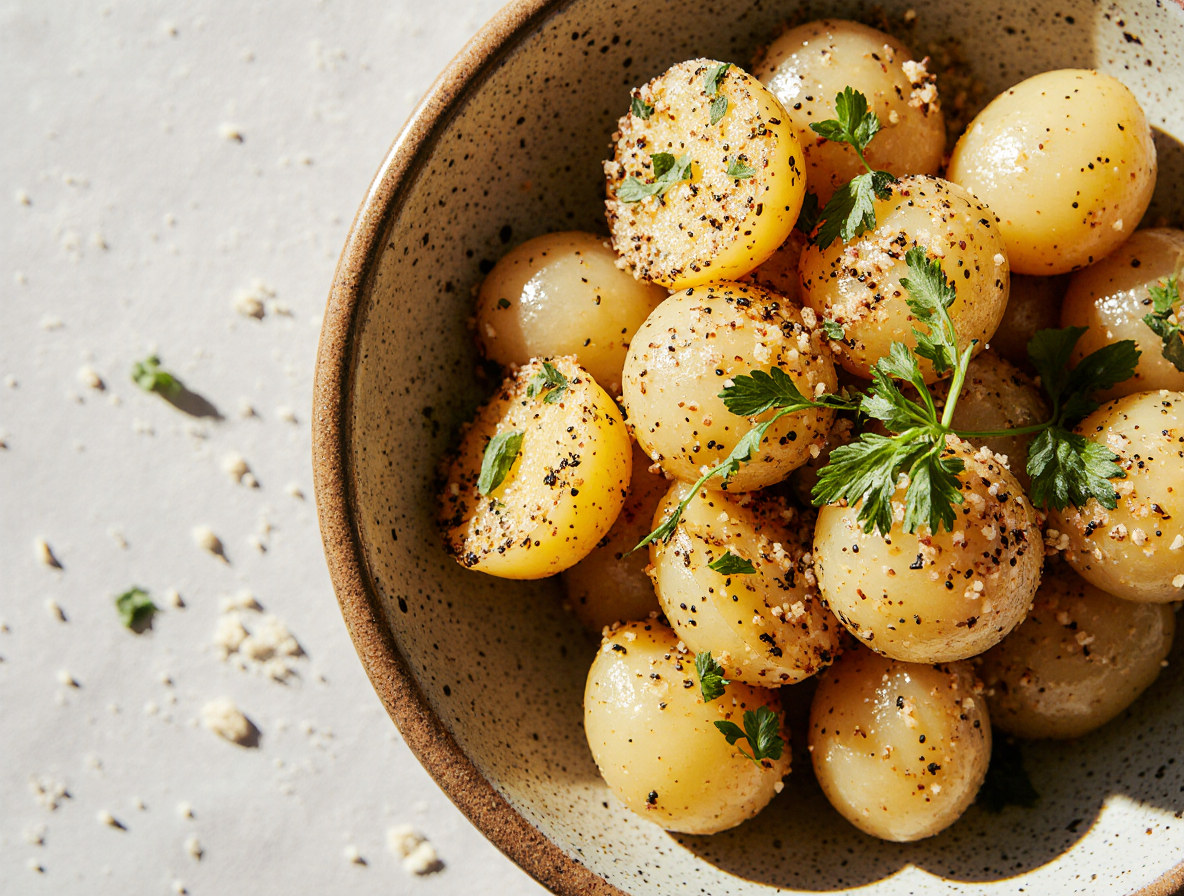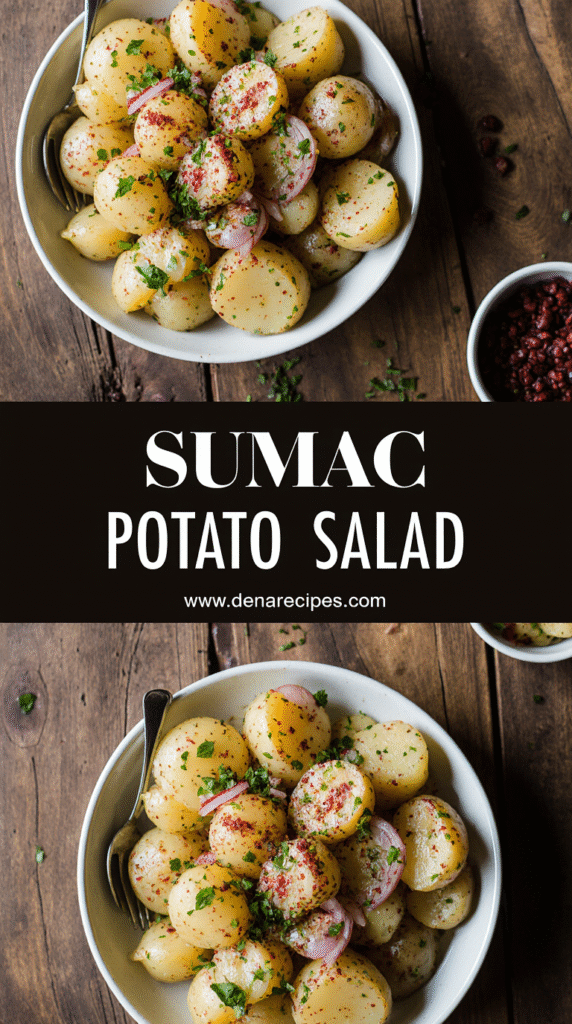How to Make Sumac Potatoes: A Foolproof Middle Eastern Recipe
Have you ever tasted sumac potatoes? Unlike traditional mayo-laden potato salads that weigh you down, this Mediterranean version relies on fresh herbs, tangy sumac, and olive oil for a flavor that’s both light and bold.
Every culture has their treasured potato salad recipe, but this Lebanese potato salad (called Salatet Batata in Arabic) skips the heavy dressings and instead embraces bright citrus notes. Whether you’re interested in sumac roasted potatoes, crispy sumac smashed potatoes, or even roasted sumac potatoes with a golden crust, the combination of lemon sumac potatoes creates a dish that’s refreshingly different. Additionally, for those looking to experiment further, sumac roasted sweet potatoes offer a delightful sweet-tangy contrast.
This isn’t your average picnic side dish. In this article, we’ll walk you through our foolproof method for creating perfect sumac potatoes that are sure to please at any gathering, family dinner, or summer picnic. From choosing the right potatoes to mastering the sumac dressing, we’ve got you covered with a healthy makeover of this classic dish.
Choose the Right Potatoes and Prep Them
The foundation of perfect sumac potatoes begins with selecting the right variety and preparing them properly. The choices you make at this stage directly impact the final texture and flavor of your dish.
Best potato types for texture and flavor
For sumac potatoes, waxy varieties work exceptionally well as they maintain their shape after cooking. Consider these options:
- Yukon Gold – Offers a buttery texture and golden color that pairs beautifully with sumac
- Baby potatoes or fingerlings – Their uniform size ensures even cooking
- Red potatoes – Hold together nicely in salads
While most recipes call for waxy potatoes, russet potatoes actually absorb flavors more readily. This makes them an interesting alternative if you’re looking for potatoes that really soak up that tangy sumac dressing, though they may break down more easily.
Why starting in cold water matters
Always place your potatoes in cold salted water before turning on the heat. This technique isn’t just chef’s superstition—it’s science. When potatoes heat gradually from cold water, they cook evenly throughout.
Moreover, starting cold allows the potatoes to pass through lower temperature ranges (approximately 120-160°F) where their natural pectin strengthens, helping them maintain a creamy, cohesive texture. Conversely, dropping potatoes into already boiling water often results in mushy exteriors while the centers remain undercooked.
To peel or not to peel?
This question ultimately comes down to personal preference and the potato variety you’ve chosen. Generally speaking:
- Baby potatoes and red varieties have tender skins that can be left on
- Keeping the skin adds fiber, nutrients, and a rustic appearance to your sumac potatoes
- For russet or larger potatoes, peeling might yield a more refined texture
If you decide to leave skins on, simply scrub the potatoes thoroughly before cooking. For a compromise approach, cook with skins on, then remove any that naturally loosen during cooking.
Make the Perfect Sumac Dressing
The zesty sumac dressing truly brings these potatoes to life with its vibrant flavor profile. After properly preparing your potatoes, let’s focus on creating that perfect tangy coating that makes sumac potatoes so irresistible.
Key ingredients: olive oil, lemon, sumac
A stellar sumac dressing begins with quality ingredients. High-quality extra virgin olive oil forms the foundation of this dressing—it genuinely makes a difference in the final flavor. For the acidic component, you have options: fresh lemon juice provides bright citrus notes, although red wine vinegar often yields superior results in taste tests and creates a beautiful color that complements the sumac.
The star ingredient, sumac, offers a tart, fruity flavor reminiscent of lemon but less acidic. This Middle Eastern spice is increasingly available in regular grocery stores, typically in the spice aisle. For balance, a small amount of honey or maple syrup helps counteract the acidity without overwhelming the dressing.
A basic ratio to remember: ¼ cup olive oil to about 3 tablespoons of acid (lemon juice or vinegar), with 1-2 teaspoons of sumac.
Optional add-ins: garlic, mustard, pomegranate molasses
Elevate your sumac dressing with these flavorful additions:
- Garlic: Either freshly minced or garlic powder adds depth. Some chefs even recommend grating garlic on a microplane for smoother texture.
- Dijon mustard: Just ¾-1 teaspoon helps emulsify the dressing while adding subtle complexity.
- Pomegranate molasses: This sweet-tart syrup is considered essential in authentic Middle Eastern dressings, adding richness and depth.
- Dried herbs: Oregano or mint complement the sumac beautifully.
For a creamier variation, consider incorporating tahini or Greek yogurt.
Whisking technique for a glossy finish
The secret to a perfectly emulsified dressing lies in the technique:
First, combine all ingredients except the olive oil in a small bowl or jar. Subsequently, slowly drizzle in the olive oil while whisking constantly. This gradual addition is crucial for building a proper emulsion.
Alternatively, place all ingredients in a mason jar with a tight lid and shake vigorously until well mixed. For an exceptionally smooth dressing, consider briefly blending the ingredients.
Fresh sumac dressing can typically be refrigerated for 2-3 weeks. However, dressings made with fresh lemon juice are best used within a few days as citrus loses its brightness over time.
Assemble and Toss the Salad
With perfectly cooked potatoes and tangy dressing ready, it’s time for the crucial assembly stage that makes or breaks your sumac potatoes. This step requires attention to detail, especially regarding temperature and technique.
Tossing while warm vs. cold
The temperature of your potatoes significantly affects flavor absorption. Tossing sumac potatoes while still warm allows them to soak up more dressing, intensifying the flavor. Nevertheless, either approach works well—this versatile dish can be served warm, at room temperature, or chilled.
For maximum flavor penetration, particularly with russet varieties that naturally absorb more seasoning, add the dressing while potatoes retain some warmth. Conversely, if you prefer distinct, firmer potato pieces in your final dish, let them cool completely before assembling.
How to avoid mushy potatoes
Preventing mushiness begins during cooking. Aim for potatoes that are fork-tender yet still hold their shape—the “al dente” sweet spot. One chef’s secret: add a teaspoon of vinegar to the cooking water (one tablespoon per quart). This acid helps stabilize the potato’s exterior, significantly reducing the likelihood of crumbling.
When mixing, handle with care. Gently fold ingredients together rather than vigorously stirring. This careful approach preserves the integrity of each potato piece throughout the tossing process.
Balancing flavors with herbs and spices
Fresh herbs transform simple sumac potatoes into something extraordinary. Consider including:
- Parsley and mint (traditional Lebanese choices)
- Dill (adds brightness)
- Green onions (for mild onion flavor)
For onions with milder flavor, briefly rinse thin slices in cold water before adding. Fresh herbs are essential—dried alternatives simply won’t deliver the same vibrant flavor.
Beyond sumac, consider adding Aleppo pepper for gentle heat or dried mint for cooling notes. The beauty of sumac potatoes lies in their ability to improve with time. Allowing the salad to rest for 30 minutes before serving lets flavors meld beautifully, making this dish ideal for preparing ahead.
Variations and Serving Ideas
Beyond the classic sumac potato salad, this versatile Middle Eastern dish offers several delicious variations to explore in your kitchen.
Sumac roasted potatoes
For a crispy alternative, try oven-roasted sumac potatoes. Toss potato wedges with olive oil, sumac, and salt before baking at 425°F until golden and caramelized. These make a perfect side dish for grilled chicken or fish with their crispy exterior and tender center.
Lemon sumac potatoes
Essentially a brighter version of the classic, lemon sumac potatoes feature additional fresh lemon juice and zest for an intensified citrus flavor. This variation pairs wonderfully with Mediterranean mains and creates a refreshingly zesty side dish that brightens any meal.
Sumac roasted sweet potatoes
Sweet potatoes offer a delightful contrast to sumac’s tanginess. Roast sweet potato wedges with sumac, a pinch of cayenne, and a drizzle of honey for a sweet-tangy flavor combination that’s truly outstanding. The caramelization from roasting complements sumac’s lemony notes beautifully.
What to serve it with: mezze, grilled meats, or fish
Sumac potatoes shine as part of a mezze spread alongside hummus and pita. They also complement grilled meats brilliantly—particularly chicken kabobs, beef skewers, or lamb. For seafood lovers, pair with grilled fish like branzino or salmon for a complete meal.
Make-ahead and storage tips
Fortunately, sumac potatoes improve with time as flavors meld. Prepare up to 2 days ahead, storing components separately until serving day. Leftovers keep 3-5 days refrigerated in airtight containers. For best results, bring to room temperature before serving.
Conclusion
Sumac potatoes stand as a remarkable alternative to traditional heavy potato salads, offering bright flavors through simple, quality ingredients. Throughout this guide, we’ve explored every aspect of creating this Middle Eastern delight, from potato selection to serving suggestions.
Remember that your potato choice significantly impacts the final dish. Waxy varieties maintain their shape beautifully, while russets absorb more of that tangy sumac flavor. Starting with cold water ensures even cooking, regardless of which variety you select.
The dressing undoubtedly makes this dish special. Fresh lemon juice or red wine vinegar combined with quality olive oil and sumac creates that signature tang. Additional ingredients like garlic, pomegranate molasses, or mustard can further elevate your dressing to new heights.
Careful assembly techniques prevent the dreaded mushiness that ruins many potato salads. Gentle folding and mindful temperature control help maintain the perfect texture. Fresh herbs then transform the dish from good to exceptional.
Most importantly, sumac potatoes offer incredible versatility. You can roast them for a crispy alternative, add extra lemon for brightness, or even swap in sweet potatoes for a sweet-tangy contrast. They pair wonderfully with mezze spreads, grilled meats, or seafood, making them suitable for countless occasions.
We hope this foolproof guide inspires you to bring these vibrant Middle Eastern flavors into your kitchen. After all, once you’ve mastered sumac potatoes, you’ll find yourself returning to this recipe whenever you crave something both familiar and refreshingly different from ordinary potato dishes.
FAQs
Q1. What makes sumac potatoes unique? Sumac potatoes offer a refreshing alternative to traditional potato salads, featuring a tangy, lemony flavor from sumac spice, olive oil, and fresh herbs instead of heavy mayo-based dressings.
Q2. Which type of potatoes work best for sumac potatoes? Waxy potato varieties like Yukon Gold, baby potatoes, or fingerlings are ideal as they maintain their shape after cooking. However, russet potatoes can be used if you prefer a texture that absorbs more flavor.
Q3. How should I prepare the sumac dressing? Combine high-quality olive oil, lemon juice or red wine vinegar, and sumac as the base. Optional add-ins include garlic, Dijon mustard, or pomegranate molasses. Whisk or shake the ingredients together for a well-emulsified dressing.
Q4. Can I make sumac potatoes ahead of time? Yes, sumac potatoes can be prepared up to 2 days in advance. The flavors actually improve with time. Store the components separately until serving day, and keep leftovers refrigerated for 3-5 days.
Q5. What are some variations of sumac potatoes? Popular variations include sumac roasted potatoes (crispy oven-baked version), lemon sumac potatoes (with extra citrus flavor), and sumac roasted sweet potatoes (for a sweet-tangy contrast). These can be served as part of a mezze spread or paired with grilled meats and fish.


